Run-up angle and jump direction – are they important for fast bowlers?
Pace Doctor | May 29, 2024
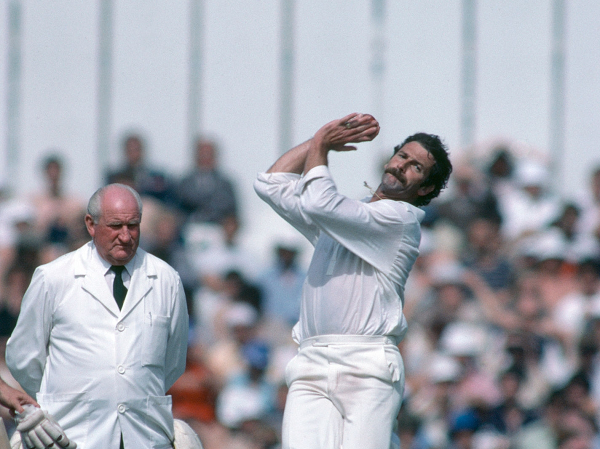
Recently I’ve been doing a number of bowling analyses for some up and coming junior teenage fast bowlers. One thing that struck me was how often these young bowlers had their momentum mis-aligned through the delivery stride.
The most common problem was momentum heading towards fine leg at the beginning of the delivery stride (back foot landing), which often results in some sort of correction later in the delivery stride. Often this ‘correction’ is displayed as an excessive lateral flexion of the upper body to the off-side, to create a resultant ball trajectory at the batters stumps. This creates extra stress for the bowler, usually through their front hip joint, pelvis and/or lower back. Sometimes all three.
Increased lateral flexion of the trunk has been linked to back injuries in some studies, but it hasn't been a consistent finding across all studies. We don’t need to eliminate lateral flexion, it plays an important role in overhead projectile activities (see pic below), but excessive amounts can be stressful, but just as importantly it is a performance limiter for the fast bowler.
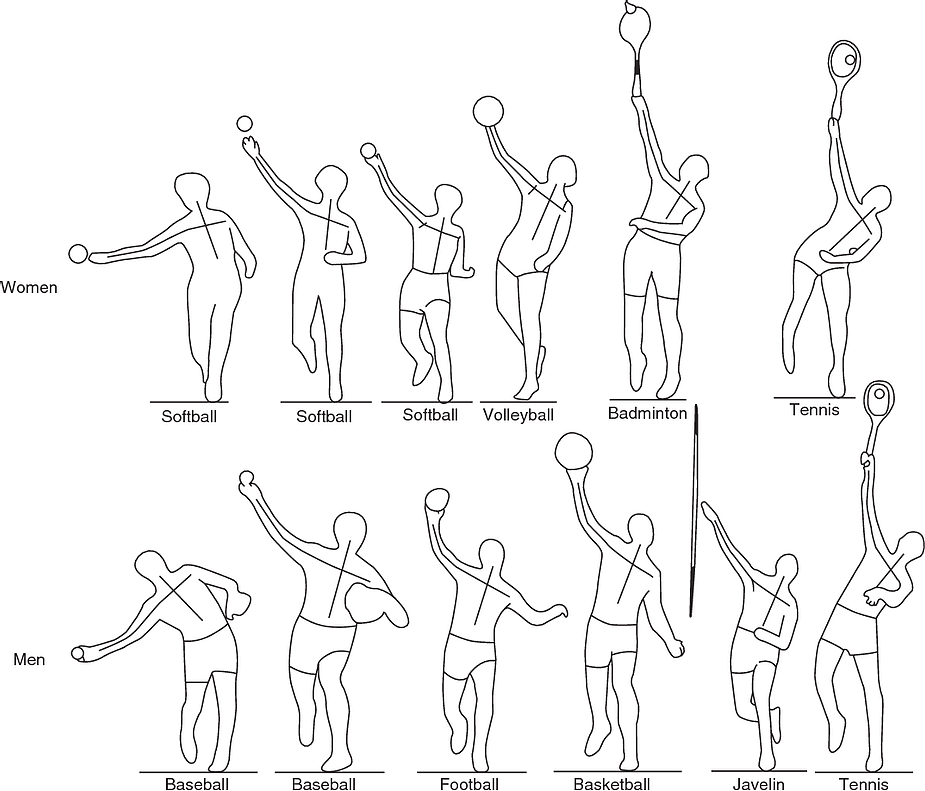
A range of projectile activities for women and men showing the relationship between the striking or releasing arm and trunk lateral flexion. The more extreme lateral flexion positions are on the right with the overhead release positions, similar to cricket fast bowling. As can be seen, trunk lateral flexion is a normal characteristic of overhead projectile activities (from Glaziers 2010 adaption of Atwater’s original 1979 paper).
Excessive lateral flexion creates another moving part – or an extra 'degree of freedom' – for the fast bowler to control to maintain pace, line and length. As a general rule large trunk lateral flexion does not help generate pace, skews the arc of the bowling arm plane and decreases the margin of error to release the ball at the target. This last point is the most important reason to change this flaw, the appropriate time to release the ball is a lot smaller to get the right line and length, and hence the bowler becomes inconsistent. What I have been finding in my analyses is that bowlers who have their run-up and/or jump momentum heading towards ‘fine-leg’, often feature excessive amounts of lateral trunk flexion through ball release. Anecdotally, the relationship seems moderate to large (but I don't have the stats to back it up!).
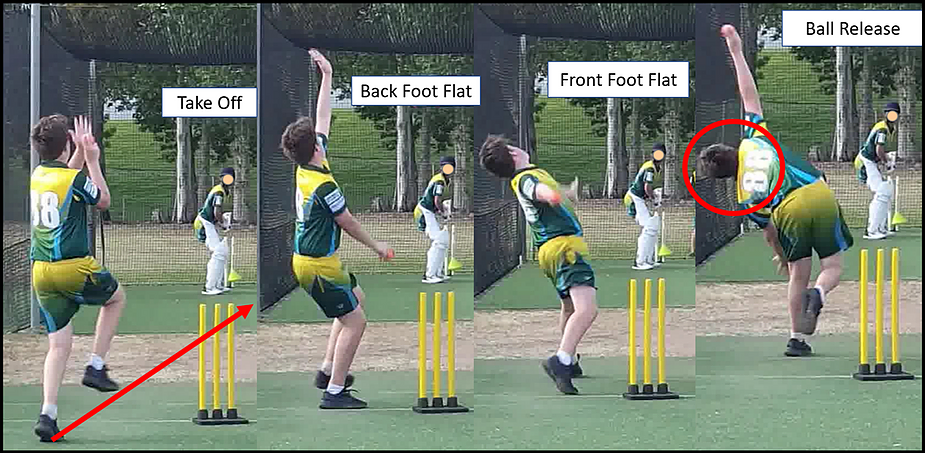
A young fast bowler whose jump momentum is directed as per the red arrow in the left image. The right most image shows the end of the delivery phase where the bowler releases the ball with a large lateral flexion of the trunk (note the head position circled in red).
The below diagram illustrates this from a ‘bird’s eye’ view to clarify the effect seen.
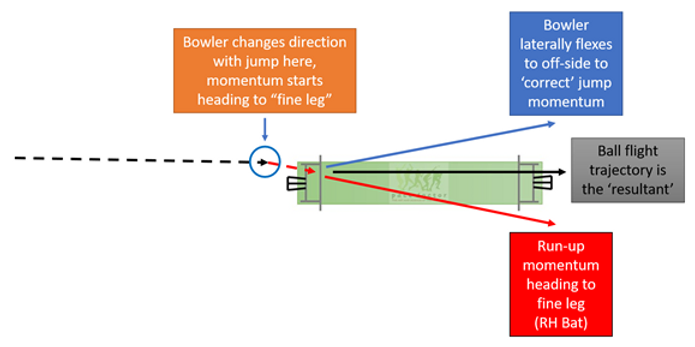
So how do you fix it? Well the simplest recommendation is to use a straight run-up, straight jump and in general terms try and get as much of your momentum heading at the target as possible (see below diagram). This is a simple ‘geometric’ solution that often works. If you can find a simple solution that works, use it. Sometimes however, bowlers who use a semi-open or side-on action will struggle with this change, and they will still jump in towards the stumps at the end of their straight run up. Often this is the bowlers who naturally bowl with a more side-on action that do this, as it presumably feels easier to get in the side on position and bowl close to the stumps.

Schematic of straight run up and straight jump, allowing as much momentum and energy to be directed at the target.
Another solution that is not often used but worth a look is allowing the side-on or semi-open bowler to keep the angled run up, particularly if that is what they are used to. The key thing to change in this situation is the body's direction of momentum in the penultimate foot contact before the flight phase. So, in other words, change the direction of the run up one foot contact earlier, so they can jump straight at the target and achieve a side-on or semi-open position at back foot landing. Dennis Lillee was a proponent of this run-up technique in the latter stages of his very successful bowling career. See the image series below of Lillee bowling in England in the early 80's.

Dennis Lillee illustrating the angled run-up. He changed his momentum direction at the penultimate foot contact (Illustrated by the green circle) before the flight phase, ensuring his momentum was heading at the target during flight and the delivery stride. Many young bowlers change their momentum direction with the jump foot contact (illustrated with the red circle above) which seems to cause many to use a large lateral flexion through ball release.
Below is the bird’s eye schematic view of the Dennis Lillee angled run-up.
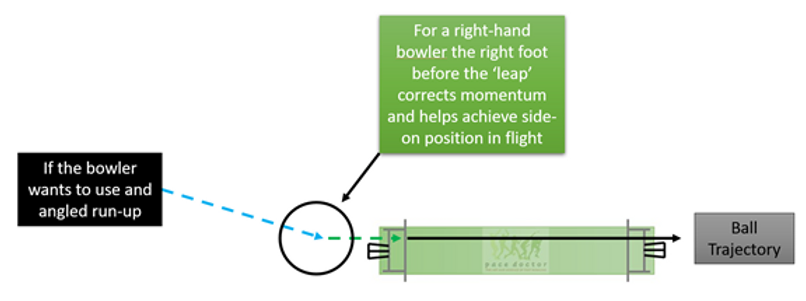
Schematic showing the angled run-up used by Dennis Lillee later in his career. By the time he was in delivery stride his momentum had been straightened and directed at the target. The second to last foot contact before the jump is the foot contact to do this effectively.
So if you or someone you coach is a big lateral flexor and is a side-on or semi-open bowler, check out where their momentum is heading as they hit the delivery stride. Correcting that jump direction may be the first critical factor to help reduce lateral flexion, and also improve accuracy and consistency.
Marc Portus
Founder - Pace Doctor
?








